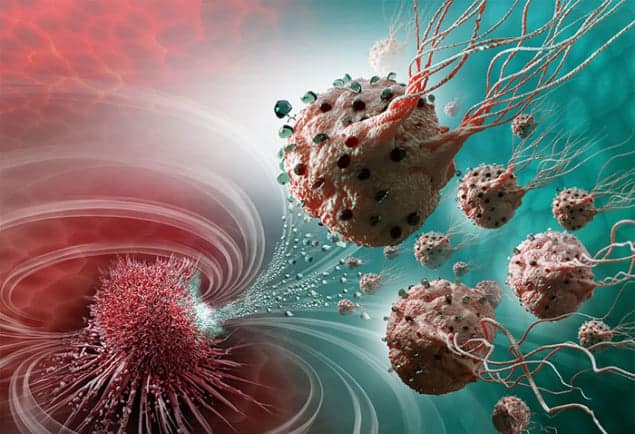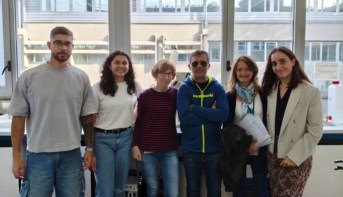
Bacteria that respond to magnetic fields and low oxygen levels may soon join the fight against cancer. Researchers in Canada have done experiments that show how magneto-aerotactic bacteria can be used to deliver drugs to hard-to-reach parts of tumours. With further development, the method could be used to treat a variety of solid tumours, which account for roughly 85% of all cancers.
Cancer cells in a growing tumour consume large amounts of oxygen and parts of the tumour will become starved of oxygen – or hypoxic. It is notoriously difficult to deliver tumour-destroying drugs to these hypoxic regions using conventional pharmaceutical nanocarriers, such as liposomes, micelles and polymeric nanoparticles.
Now, a team led by Sylvain Martel of the NanoRobotics Laboratory at the Polytechnique Montréal – including researchers at McGill University – has developed a method that exploits the magnetotactic bacteria Magnetoccus marinus (MC-1) to overcome this problem.
Tiny compass needles
A MC-1 bacterium has a chain of magnetic nanoparticles that acts like a microscopic magnetic compass needle. The bacteria live in saltwater estuaries in the northern hemisphere, where they use the Earths’s geomagnetic field to point them towards deeper water with low oxygen concentrations. The microbes do this because they thrive where oxygen concentrations are low. Indeed, the oxygen levels found in hypoxic regions of a tumour – about 0.5% – are perfect for MC-1.
The researchers created an artificial environment to allow these bacteria to migrate towards the hypoxic regions of tumours in live mice with colorectal cancers. “We first produce a weak magnetic field pointing towards the tumour to guide drug-loaded bacteria and make them swim towards the tumour (a process called magnetotaxis),” says Martel. “Once inside the tumour and sufficiently close to the hypoxic zones, we remove the magnetic field to allow the bacteria to use their internal oxygen sensors (aerotaxis) and follow the decreasing oxygen gradient in the tumour until they reach the 0.5% oxygen level.”
These bacteria can be used as general transport vehicles to carry a huge variety of therapeutic agents, such as various drug molecules, radiotherapeutic agents, stem cells and immunotherapeutics. “In the short term, we will be using our technique to study how it can enhance cancer treatment,” says Martel. “The possibilities are vast, since all therapeutic agents for treating solid tumours share a common problem – the effective delivery to the site of treatment.”
Therapeutic agents
Looking further into the future, the researchers say they would like to look into the efficacy of various therapeutic agents that are delivered using their new technique. They also hope to collaborate with other research groups around the world.
In the next few months the team will begin to develop medical protocols based on the technique. Also planned is the implementation of mathematical models to improve how magnetic fields are used to guide the bacteria. They will also continue doing studies of the safety of the technique, which Martel says “are encouraging so far”.
The new technique is described in Nature Nanotechnology.
- A version of this article first appeared on nanotechweb.org



